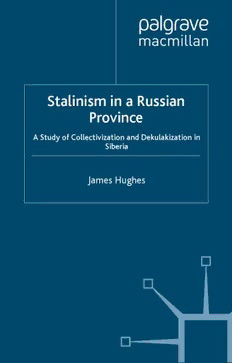
Stalinism in a Russian Province: A Study of Collectivization and Dekulakization in Siberia PDF
Preview Stalinism in a Russian Province: A Study of Collectivization and Dekulakization in Siberia
Stalinism in a Russian Province A Study of Collectivization and Dekulakization in Siberia James Hughes STALINISM IN A RUSSIAN PROVINCE AlsobyJames Hughes STALIN, SIBERIA ANDTHECRISIS OFTHE NEW ECONOMIC POLICY Stalinism in a Russian Province A Study of Collectivization and Dekulakization in Siberia James Hughes Lec/llrerinRussianPOlilics, DeparlmenlojGol'ernmell1 LOlldonSchoolojEconomicsandPolilicedScience in association with the Centre for Russian and East European Studies University ofBirmingham * ©JamesHughes1996 Allrightsreserved.Noreproduction,copyortransmissionof thispublicationmaybemadewithoutwritten permission. Noparagraphofthispublicationmaybereproduced,copiedor transmittedsavewithwrittenpermissionorinaccordancewith theprovisionsoftheCopyright,DesignsandPatentsAct1988, orunderthetermsofanylicencepermittinglimitedcopying issuedbytheCopyrightLicensingAgency,90TottenhamCourt Road,londonWlPOlP. Anypersonwhodoesanyunauthorisedactinrelationtothis publicationmaybeliabletocriminalprosecutionandcivil claimsfordamages. Theauthorhasassertedhisrighttobeidentifiedastheauthorofthis workinaccordancewiththeCopyright,DesignsandPatentsAct1988. Publishedby PAlGRAVE Houndmills,Basingstoke,HampshireRGZl 6XSand 17SFifthAvenue,NewYork,N.Y.10010 Companiesandrepresentativesthroughouttheworld PAlGRAVEisthenewglobalacademicimprintof St.Martin'sPressllCScholarlyandReferenceDivisionand PalgravePublishersltd(formerlyMacmillanPressltd). ISBN0-333-65748-9 Thisbookisprintedonpapersuitableforrecyclingand madefromfullymanagedandsustainedforestsources. Acataloguerecordforthisbookisavailable from theBritishLibrary. TransferredtodigitalprintingZ001 Printedand boundinGreatBritainby AntonyRoweltd,Chippenham,Wiltshire for Julia This page intentionally left blank Contents List ofTables viii Preface IX List ofAbbreviations xii Map ofthe Siberian Krai in 1930 xiii Introduction 1 Capturing the Peasantry 7 2 Mobilizing Social Influence 33 3 The Search for a New Method 52 4 The Ural-Siberian Method 73 5 Volynki: The Russian Jacquerie 92 6 A Prologue ofRepression 111 7 Stalin's Final Solution 136 8 Barshchina and Maroderstvo 160 9 The Great U-turn 183 Conclusion 204 Notes 217 Appendix: Documents 249 Bibliography 258 Glossary 264 Index 266 List of Tables 4.1 The piatikratniki: compulsory registrations and compulsory auctions of peasant property in Siberia (March-May 1929) 74 4.2 A comparison of procurement levels in Siberia in March-April 1928 and 1929 85 6.1 Compulsory grain quotas on peasants in Siberia in 1928/9 and 1929/30 123 6.2 Punishment policy under Article 61 in Siberia in 1929/30 126 7.1 Siberian OGPU statistics on dekulakization, to 24 February 1930 154 9.1 The level of collectivization in Siberia, 1 July 1929 to 1 May 1930 195 9.2 Siberian OGPU statistics on the deportation of Category Two kulaks, to 24 February 1930 200 Preface Stalin designated 1929 the year of the 'great breakthrough' in Russian history.Thecataclysmoftheself-declared 'revolutionfrom above' marked the decisive turning point where Stalin propelled the country into a dash for growth: a planned 'great leap forward' that would stake out the con struction ofthe Stalinist state. Itarticulated and released the pressures for changeto thestatusquoofthe New EconomicPolicy(NEP) thathadbeen building up in the Communist Party during the 1920s. The Stalinist revo lution was an attempt to smash a conjuncture ofeconomic, political and contingentconstraints obstructing the realization ofthe Bolshevikideal of amodernizing transformationoftheSovietUnion. Afterthegraincrisisof 1927/8,the Stalinistshadcometo view theexistenceofa marketoriented free peasantry underNEPas themainconstrainton the buildingofsocial ism.Thesuccessofamodernizingcrashindustrializationprogrammehinged on a resolution ofthe question ofwho would control the countryside, the peasantorthestate. For, given theSovietUnion's backwardness, whoever won this battle would dictate the nature and pace of the development of the country. This study is acontinuation ofthe author's previous work, Stalin, Sibe ria and the Crisis ofthe New Economic Policy, that investigated the re lationship between contingency, Stalin's personal experiences ofSiberian conditions and the abandonment of NEP during the grain crisis. In this book the focus of analysis has been taken forward to examine the after math of the grain clisis and the evolution of the primary programmatic pillar of the Stalin revolution: the formation and implementation of the policiesofforced collectivizationanddekulakization.Itwas theresolution ofthe peasantquestion which shaped the entire modernization process in Soviet Russia, for collectivization subordinated the peasant economy to the demands ofthe state-ledrapid industrialization which was the founda tion of the Stalinist state. In preparing this book I have sought to build on the strengths of my expertise on one Russian province, Siberia, as well as attempting to be responsivetocriticismsofstructuralfaults in myearlierworkthatfocused on its non-archival source base. The revolution in historical investigation inRussiathathasoccurredfollowing thedisintegrationofcommunismhas beendriven notonly by muchfreer access to archivespreviouslyclosedto foreign scholars, but also by the unbrokered exchange ofideas and mate rials through personal, scholar-to-scholar contacts. The new environment
